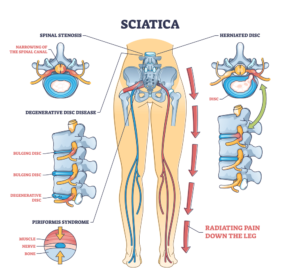 Sciatica is a common condition that causes pain, numbness, or tingling that radiates from the lower back down the leg. It typically occurs when there is compression or irritation of sciatic nerve at lumbar level or during its course through the leg. The common causes are mostly: Herniated disc, spinal stenosis, degenerative disc disease, spondylolisthesis, piriformis muscle tightness or poor sitting posture, especially when someone sits on their wallet under hip.
Sciatica is a common condition that causes pain, numbness, or tingling that radiates from the lower back down the leg. It typically occurs when there is compression or irritation of sciatic nerve at lumbar level or during its course through the leg. The common causes are mostly: Herniated disc, spinal stenosis, degenerative disc disease, spondylolisthesis, piriformis muscle tightness or poor sitting posture, especially when someone sits on their wallet under hip.
Management of sciatica often includes combination of rest, physiotherapy, spinal support, gentle mobility exercises and dry needling. Physiotherapy is a highly effective treatment option for sciatica, as it can help improve flexibility, strength, and range of motion in the affected area. As the intensity of problem varies from case to case, physiotherapist will do a thorough assessment with you to develop a personalized treatment plan that may include exercises, manual therapy, and education on proper posture and body mechanics.
Dry needling is also a very effective technique used by physiotherapists to target trigger points in the muscles that may be contributing to your pain. By inserting a thin needle into these trigger points, the therapist can help release tension and improve blood flow to the area, promoting healing and reducing pain.
If you are experiencing low back pain or radiating leg pain, it is important to seek treatment from a qualified physiotherapist near you. They can create a treatment plan to help you recover and get back to your daily activities. Don’t let sciatica hold you back – contact a physiotherapist today to start feeling better.
Exercises can be an effective way to help manage and alleviate the symptoms of sciatica. Here are top 5 exercises for sciatica pain:
- Piriformis Stretch: Sit on a chair with your feet flat on the floor. Cross your affected leg over the other knee and gently lean forward to stretch the piriformis muscle, which can help relieve pressure on the sciatic nerve.
- Hamstring Stretch: Lie on your back with one leg extended and the other bent. Slowly straighten the bent leg using a towel wrapped around foot while keeping the other leg on the floor, stop as you feel stretch in the hamstrings. Gently work on improving the range of motion. Hold for 30 seconds and repeat 3-4 times.
- Pelvic Tilt: Lie on your back with your knees bent and feet flat on the floor. Tighten your abdominal muscles and press your lower back into the floor, holding for a 5-6 seconds without holding breath and then release.
- Knee to chest stretch: Hold one leg around knee and bring it to your chest. Hold it for 20 seconds and then repeat on other side. Initially keep the other leg bent.
- Core Strengthening: Exercises like bridges, cat and camel exercise and abdominal isometrics can help strengthen the core muscles, which can provide support for the lower back and reduce the load on intervertebral space during movements.
It is important to consult with a physiotherapist or healthcare provider before starting any new exercise program, especially if you are experiencing severe symptoms. They can provide guidance on the best exercises for your specific condition and make sure that you are doing them correctly.

